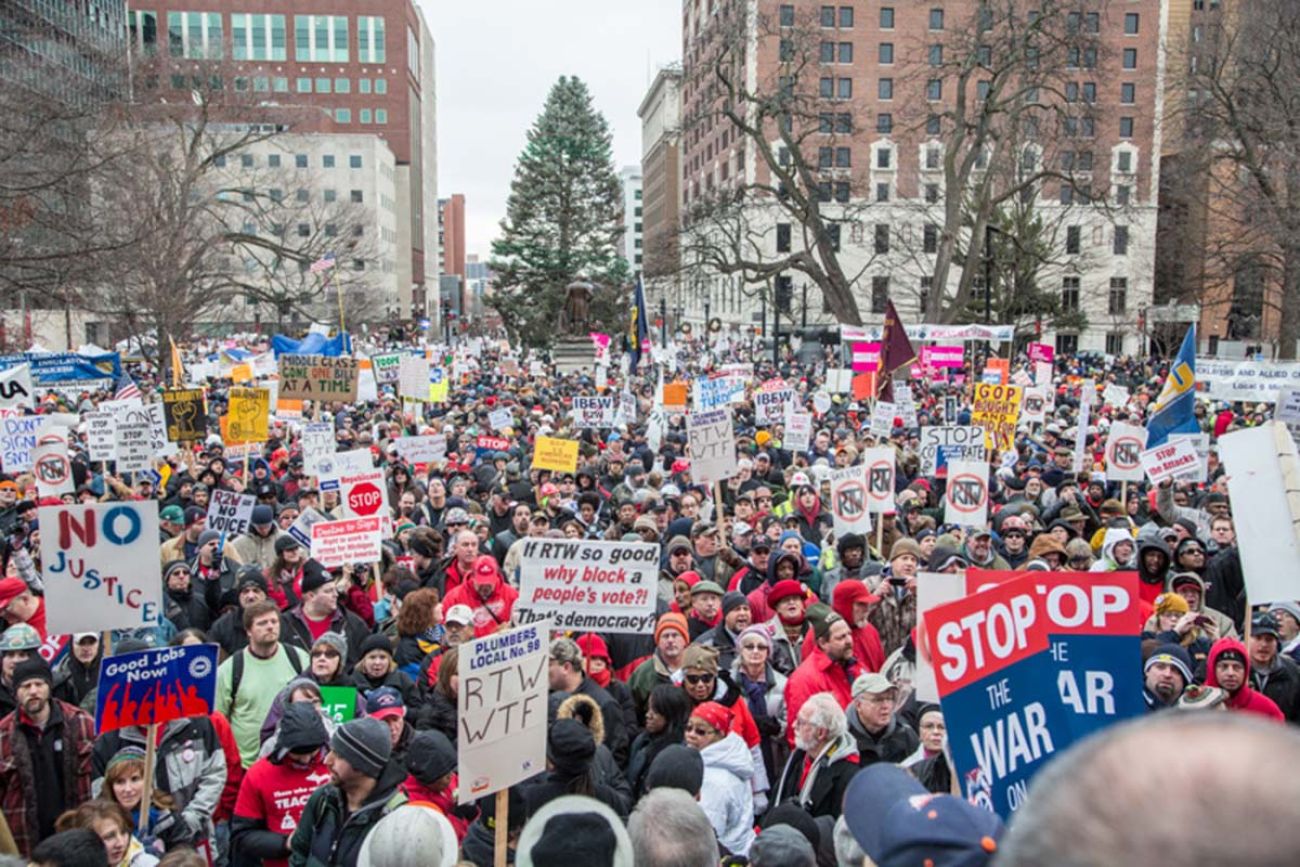What is Michigan Right-to-Work: How law impacted wages, jobs, unions

- Right-to-Work allows workers to opt out of paying dues in union-represented jobs but still receive benefits.
- 27 states have similar laws, which unions say hurts them financially and makes it harder to organize
- Wages grew 12 percent in Michigan since Right-to-Work was adopted, below the rate of inflation
March 24: Whitmer signs Right-to-Work repeal, prevailing wage restoration
March 21: Right to Work repeal, prevailing wage poised to pass and head to governor
March 14: Right-to-Work repeal soon headed to Gov. Gretchen Whitmer. Now what?
Michigan Democrats are moving fast to repeal the state’s Right-to-Work law that allows workers to opt out of paying dues in union-represented jobs but still receive benefits.
Along party lines, the state House voted on Thursday to repeal the 2012 law. The state Senate could follow suit next week, sending legislation to the eager pen of Gov. Gretchen Whitmer, a Democrat who favors the repeal.
Here’s what to know about the law, why it’s controversial and what both sides of the debate say.
Related:
- Michigan Right-to-Work backers plot ballot proposal as Dems pursue repeal
- Michigan House votes to repeal Right-to-Work, restore prevailing wage
- Historic day for LGBTQ rights, as anti-discrimination bill goes to Whitmer
- Michigan Senate votes to repeal abortion penalties under 1931 ban
What does Right-to-Work mean and how many states have similar laws?
Under Right-to-Work laws, unions retain the right to organize and collectively bargain but cannot require members to pay dues. The measures have reduced the amount of money unions have to pay leaders, administer contracts and organize new businesses.
Michigan is one of 27 states with Right-to-Work laws, joining Indiana and Wisconsin in the Great Lakes region. All southern states and many Plains and western states also have the laws.
Why do unions want to repeal it?
Unions have argued the laws have hurt workers’ ability to organize by lowering funding for unions who need money to organize groups of employees. They also claim that wage growth is lower in states with Right-to-Work laws — which critics say is the goal of Right-to-Work.
What do foes of the repeal say?
That it’s anti-business and will make it harder for Michigan to land big investments. In a Wednesday statement, House Republican Leader Matt Hall, R-Richland Township, said the repeal would “steer workers and businesses away from our state, when we’re already falling behind.”
The law was touted in part in 2012 as a way to lure more business to the state. However, Michigan has continued to lag the nation in unemployment and growth, both before the change and after.
Why did Michigan adopt the law?
Right-to-Work was adopted in 2012 amid controversy.
Then-Gov. Rick Snyder, a Republican, had called the law divisive and said he preferred to avoid a debate on it. But the issue erupted after a petition drive sought to enshrine union organization and collective bargaining into the state constitution.
Voters defeated that measure, prompting Republicans to approve Right-to-Work during a lame-duck session of the Legislature. Snyder signed the bills.
What do studies say?
It depends on who conducts the study. Labor-backed research has concluded the laws have eroded wages, led to higher debt and poorer health. Pro-business research has concluded it has a positive effect on economic growth. Much of that growth, however, has occurred in Right-to-Work states in the South and researchers note that warmer weather and other factors may be contributing to the rising populations and growing economies in southern states, not simply the existence of Right-to-Work laws.
What has happened to union membership?
Union membership in Michigan fell from 17.1 percent of the workforce in 2012 to 15.3 percent last year. In neighboring Ohio, which does not have a Right-to-Work law, the rate is nearly unchanged over that time: it was 13.9 percent in 2012 and 14 percent last year, according to the U.S. Bureau of Labor Statistics.
What about wages?
Manufacturing wages have grown in Michigan since Right-to-Work was adopted, but not kept pace with the increase in inflation.
They’ve grown 12 percent from 2012 to 2021, a similar growth to Indiana, which adopted Right-to-Work in 2012 as well. Over that same time frame, inflation rose 29 percent.
Hourly manufacturing wages in Michigan averaged $30.50 in Michigan in 2021 and $28 in Indiana.
Among all states, wages among private sector workers increased the most in Hawaii — which is not Right-to-Work — from 2012 to 2022.
But half of the states with the biggest gain in wages — Nevada, South Carolina, Nebraska, Alabama and Utah — are Right-to-Work states. Michigan’s wage growth ranks 31st in the nation.
See what new members are saying about why they donated to Bridge Michigan:
- “In order for this information to be accurate and unbiased it must be underwritten by its readers, not by special interests.” - Larry S.
- “Not many other media sources report on the topics Bridge does.” - Susan B.
- “Your journalism is outstanding and rare these days.” - Mark S.
If you want to ensure the future of nonpartisan, nonprofit Michigan journalism, please become a member today. You, too, will be asked why you donated and maybe we'll feature your quote next time!




